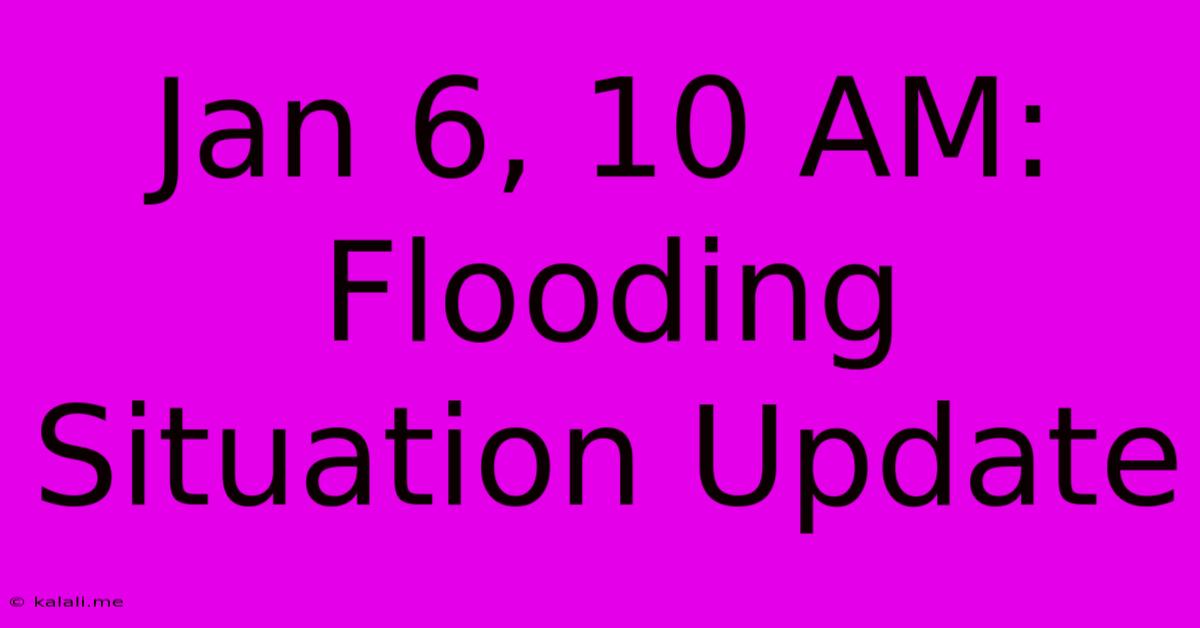Jan 6, 10 AM: Flooding Situation Update
Kalali
Jan 12, 2025 · 4 min read

Table of Contents
Jan 6, 10 AM: Flooding Situation Update: A Comprehensive Overview
The morning of January 6th brought a devastating deluge to [Specify affected region/city/state]. At 10:00 AM, the flooding situation was rapidly evolving, requiring immediate attention and coordinated efforts from emergency services, residents, and local authorities. This update provides a comprehensive overview of the current situation, including the extent of the damage, the ongoing response, and crucial safety advice for those affected.
The Extent of the Flooding
As of 10:00 AM, widespread flooding was reported across [Specify affected areas, using precise locations like street names, neighborhoods, or landmarks]. The [Name of river/water body] overflowed its banks, inundating low-lying areas and causing significant disruption to transportation and infrastructure. Initial reports suggest that [Number] homes and businesses have been affected, with varying degrees of damage ranging from waterlogged basements to complete submersion.
Key Impact Areas:
- Residential Areas: [Specify neighborhoods most severely impacted, detailing the extent of flooding and the number of affected homes]. Many residents have been evacuated, with temporary shelters established at [Location of shelters].
- Commercial Districts: Flooding has severely disrupted businesses in [Specify affected commercial areas], leading to closures and significant financial losses. [Mention specific businesses impacted, if available].
- Transportation Networks: Major roads, including [List affected roads and highways], are currently impassable due to high water levels. Public transportation services have been significantly impacted, with [Specify the impact on bus, train, or subway services].
- Critical Infrastructure: [Mention any impact on essential services such as power, gas, water supply, and communication networks]. Crews are working to restore services as quickly and safely as possible.
The Ongoing Emergency Response
Multiple agencies are collaborating to manage the unfolding crisis. [List the involved agencies, e.g., National Guard, Fire Department, Police Department, Red Cross]. These teams are actively engaged in:
Rescue and Evacuation Operations:
Rescue crews are prioritizing the evacuation of individuals trapped in flooded areas and providing assistance to those requiring immediate medical attention. Helicopters are being used in areas with particularly high water levels or inaccessible roads. The evacuation process is ongoing, and residents are urged to cooperate with emergency personnel.
Damage Assessment and Repair:
Teams are working to assess the full extent of the damage to infrastructure, homes, and businesses. This assessment will be crucial in determining the resources required for the recovery effort. Repair work will begin as soon as it is safe to do so.
Provision of Essential Services:
Emergency shelters are providing food, water, clothing, and temporary housing to those displaced by the floods. [Mention specific support organizations involved and their contribution]. Efforts are underway to restore essential services, such as power and water, to affected areas.
Communication and Information Dissemination:
Local authorities are utilizing multiple channels, including television, radio, and social media, to keep the public informed about the situation and provide updates on emergency response efforts. Residents are encouraged to follow official channels for accurate and timely information.
Safety Advice for Affected Residents
The flooding situation remains dangerous, and residents are urged to take the following precautions:
- Stay informed: Monitor official news channels and social media for updates.
- Avoid flooded areas: Do not attempt to drive or walk through flooded areas, as the water may be deeper and faster-flowing than it appears.
- Heed evacuation orders: If you are instructed to evacuate, do so immediately.
- Turn off utilities: If your home is flooded, turn off the electricity, gas, and water to prevent further damage and hazards.
- Seek higher ground: If your home is at risk of flooding, move to higher ground.
- Check on neighbors: Offer assistance to elderly or vulnerable neighbors.
- Stay safe: Be aware of potential hazards such as downed power lines, debris, and contaminated water.
Long-Term Recovery Efforts
The recovery from this devastating flood will be a long and complex process. [Mention anticipated long-term recovery plans, such as government aid programs, community support initiatives, and infrastructure rebuilding projects]. The community will need to work together to rebuild homes, businesses, and infrastructure.
Supporting the Affected Community
Many individuals and organizations are working to provide aid to those affected by the flooding. [Mention ways the public can contribute to the relief efforts, such as donating to reputable charities, volunteering time, or providing essential supplies]. Every contribution, big or small, will help those in need during this difficult time.
Potential Long-Term Impacts:
The January 6th flood will likely have long-term consequences for the region. These may include:
- Economic impact: Businesses may face long-term closures, affecting employment and the local economy.
- Environmental impact: The flood may cause significant damage to the environment, requiring extensive cleanup and restoration efforts.
- Psychological impact: Individuals affected by the flood may experience trauma and mental health challenges requiring support and resources.
This flooding situation is a stark reminder of the vulnerability of communities to extreme weather events. Continued monitoring and proactive measures are crucial in mitigating the impacts of future floods and building more resilient infrastructure. Regular updates will be provided as the situation develops. Stay safe and support your community.
(Note: Remember to replace the bracketed information with specific details relevant to the actual flooding event. This template provides a framework for a comprehensive and SEO-optimized article.)
Latest Posts
Latest Posts
-
How Many Bunnies Are There In The World
Jun 30, 2025
-
How Is A Watch And Ruler Similar
Jun 30, 2025
-
How Many Liters Is In A Water Bottle
Jun 30, 2025
-
How Many Cups Of Milk Are In A Half Gallon
Jun 30, 2025
-
How Many Ritz Crackers In A Cup
Jun 30, 2025
Related Post
Thank you for visiting our website which covers about Jan 6, 10 AM: Flooding Situation Update . We hope the information provided has been useful to you. Feel free to contact us if you have any questions or need further assistance. See you next time and don't miss to bookmark.